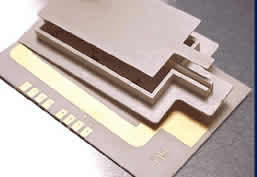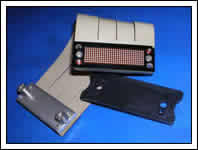Socket To Me – The Selection and Use of High Performance Insulating Materials
Socket To Me
The Selection and Use of High Performance Insulating Materials
They say big things come in small packages. Powerful things do, too, especially the latest Integrated Circuits (ICs). The proliferation of high-performance chipsets challenges designers to keep up with the continuous decrease in pitch spacing and increase in harsh environmental and electrical conditions. In many cases, materials that have stood the test of time (and cost), simply will not work and the designer must consider alternate materials for use in these powerful packages. It is important, when selecting materials, to evaluate a number of system requirements, principally addressing temperature, dielectric, and manufacturability constraints.
FR-4 and G10
 The tried-and-true friend of all circuit boards, FR-4, and prior to that, G10, have a special place in the designer’s heart, not to mention his wallet. Both are composite materials made by woven fiberglass cloth mixed with an epoxy resin, with FR-4’s binder being self-extinguishing. It’s inexpensive, easy to work with, and has served the market well since the onset of IC design. However, the advancement of manufacturing technologies, the exponential push for faster chipset processing times, and the increased temperature loads of socket assemblies, has pushed FR-4 to its limitations, and must be chosen carefully in some applications. Like Mylar film prior to the introduction to Kapton, FR-4 and G10 have certain constraints worth investigating in BGA or other package designs.
The tried-and-true friend of all circuit boards, FR-4, and prior to that, G10, have a special place in the designer’s heart, not to mention his wallet. Both are composite materials made by woven fiberglass cloth mixed with an epoxy resin, with FR-4’s binder being self-extinguishing. It’s inexpensive, easy to work with, and has served the market well since the onset of IC design. However, the advancement of manufacturing technologies, the exponential push for faster chipset processing times, and the increased temperature loads of socket assemblies, has pushed FR-4 to its limitations, and must be chosen carefully in some applications. Like Mylar film prior to the introduction to Kapton, FR-4 and G10 have certain constraints worth investigating in BGA or other package designs.
Temperature constraints are the first important factor to consider when seeking alternate insulating materials. FR-4 has an operating temperature range of -40°C to +140°C, which is fine for many standard systems but may not work for more rigorous or mission-critical applications. High pin-out systems requiring very fast processing speeds often generate very high temperatures, which may be a concern. At higher temperatures, its coefficient of thermal expansion will begin to interfere with high-density, small-pitch arrays.
Another constraint to consider when selecting an interface material is dielectric/electrical performance. Fiberglass is a good electrical insulator, but at 500 kV at 1.6 mm thick FR-4, higher-voltage applications may be at risk, and a better dielectric material or greater distance between pins may be required. In addition, during the machining process of the small thru-holes, small glass fibers are subject to micro-tears at the base of the holes, risking additional hole-to-hole dielectric breakdown.
Finally, designers also need to consider manufacturing constraints. FR-4 and G10 are very easily machined and allow for modestly small, closely packed thru-holes. Available thicknesses tend to be standardized, such as 0.8 mm and 01.6 mm thick. However, as discussed above, the presence of glass fibers held by epoxy resin throughout the material gives risk to damage at the base of the holes due to tear-out. After-processing issues may also impact the selection of FR-4 for a particular application, such as overmolding, given the extreme temperatures required for this process (250°C to 300°C). But in general, FR-4 and G10 are commonly used for many low-cost, basic BGA adaptors and other small package assemblies.
Liquid Crystal Polymer (LCP)
For applications requiring higher temperatures and higher density thru-holes, Liquid Crystal Polymers (LCP) should be explored. The nature of LCP material allows for injection molding on conventional equipment, providing precise shapes and forms for many different packages. Of course, tooling these forms needs to be considered for the application; however, the use of injection molding usually offsets the high cost of the material.

Two of the benefits of LCP are its increased temperature range and increased dielectric properties over FR-4 or G10. Many LCPs have an operating temperature range from -60°C to +260°C, allowing for more extreme environmental conditions. Also, LCPs have almost twice the dielectric strength of FR-4 (1000 kV), allowing for tighter-spaced holes, higher currents, and greater dielectric withstanding voltage.
The use of LCP does have some limitations. Even with the greater operating temperature range, overmolding plastic injection frames onto LCP components may cause physical deformations on delicate features. As stated earlier, overmolding typically requires temperatures in the 250°C to 300°C range, which could easily cause deformation of tightly controlled tolerances. However, given LCP’s tendency to be injection-molded, most secondary features would be homogenous to the design.
Cirlex
Polyimide materials are often called upon in situations where even greater temperature resistance is required while maintaining excellent electrical insulating performance. Thicker polyimide materials, such as Vespel, Torlon, and Cirlex, continue to be utilized as alternatives to glass-filled and LCP materials when mission-critical applications require a pure, precision-engineered material.
Cirlex, for example, is made from 100% Kapton polyimide film and has a glass transition temperature of 351°C, far exceeding that of other socket materials, providing exceptional stability at demanding temperatures. Its very low coefficient of thermal expansion (20 ppm/°C) along with its high tensile strength (32000 psi at 200°C at 9 mil) makes Cirlex an exceptionally strong and stable material across its operating temperature range of -269°C to 351°C. This makes Cirlex a suitable material for overmolding processes without risking critical feature deformation.
 The dielectric properties of Cirlex are also about twice that of LCPs, at 2700 kV (at 9 mil), allowing even finer density-packed, small thru-holes, capable of carrying even greater loads and temperatures, without risk of failure. Given its pure polyimide structure, it does not exhibit alternate or differing electrical characteristics, regardless of environment, as may be the case in glass-filled materials. The purity of Cirlex also lends itself to machining with CNC or laser without risk of potato-chipping, flaking, or any other deformity which residual stresses may cause. Its dead-flat, stress-free structure provides a perfect choice for thin precision BGA stencils and flat, precise custom sockets in three dimensions.
The dielectric properties of Cirlex are also about twice that of LCPs, at 2700 kV (at 9 mil), allowing even finer density-packed, small thru-holes, capable of carrying even greater loads and temperatures, without risk of failure. Given its pure polyimide structure, it does not exhibit alternate or differing electrical characteristics, regardless of environment, as may be the case in glass-filled materials. The purity of Cirlex also lends itself to machining with CNC or laser without risk of potato-chipping, flaking, or any other deformity which residual stresses may cause. Its dead-flat, stress-free structure provides a perfect choice for thin precision BGA stencils and flat, precise custom sockets in three dimensions.
Another unique characteristic of Cirlex is its availability in exact 0.001” (0.0254 mm) increments from 0.004” (0.1016 mm) up to 0.125” (3.175 mm) or thicker, versus traditional materials available only in standard fractional or mm thicknesses. This allows a wider array of design possibilities for the mechanical and electrical engineers, as the engineers can now enter the design phase with options in material thickness that were not available before. This also greatly reduces the amount of machining time required to get to final thickness tolerances, as well as overall yield, which must be considered when designing for manufacturability. In applications where extreme temperature, electrical, and environmental requirements are required, the benefits of a polyimide material such as Cirlex will be of great assistance to any package designer.
Choosing the right insulating material for a high-performance socket or adapter is a delicate balance between form, fit, function, and price. It is important for the engineer to consider all aspects of functional design of the part as it relates to the physical, electrical, and thermal properties of the environment in which it will be performing. Making certain the correct electrical insulating material is selected, whether it is glass-filled, resin-based epoxy; liquid crystal polymer; or a thick polyimide; depends on the specific application where the component will be functioning, as well as the overall environment of the application. For precision applications, making the correct choice of an electrical insulator is oftentimes less dependent on price than it is on environmental conditions, and therefore making selection of the proper material the “mission-critical” part of the process.
Richard Orstad, P.E., M.B.A., is a professional engineer with more than 20 years of experience in engineering, project and product management, manufacturing operations, and sales and marketing management. He holds several patents in electrical connector design, has written several white papers on industrial automation, and presented these topics at international conferences focused on the hard disk drive industry. Richard is the eastern regional sales manager for Fralock, a provider of precision converted engineered materials solutions for the military/aerospace, medical, and electronics industries.

